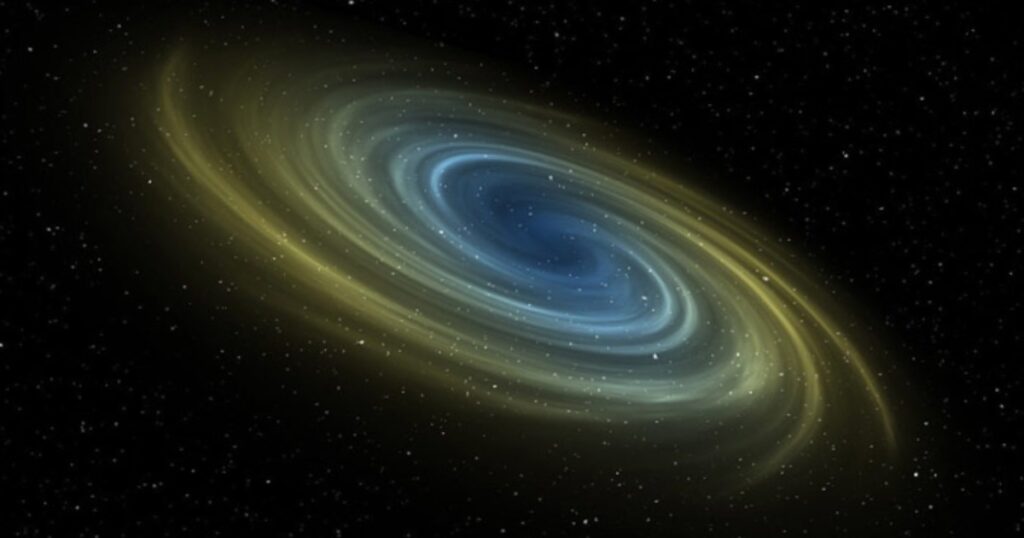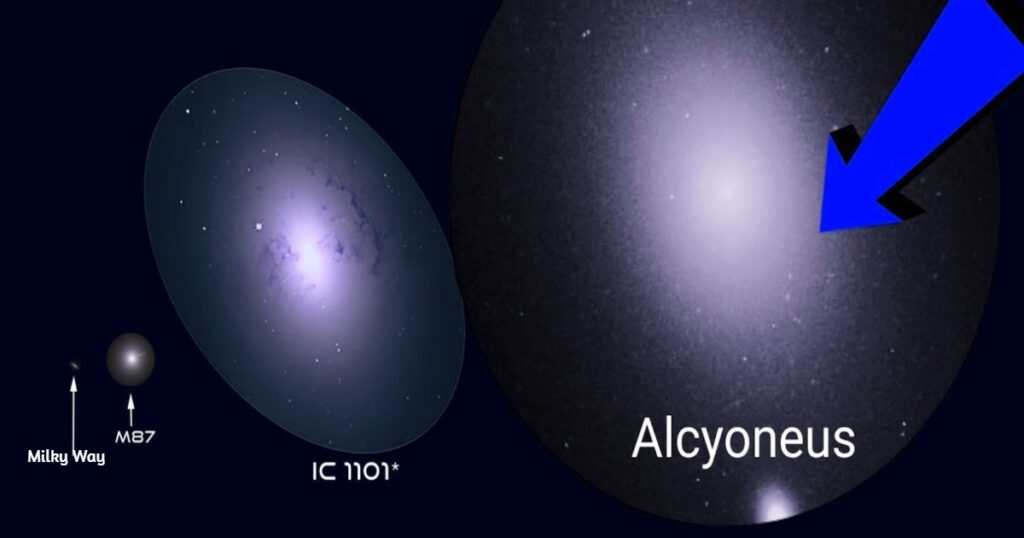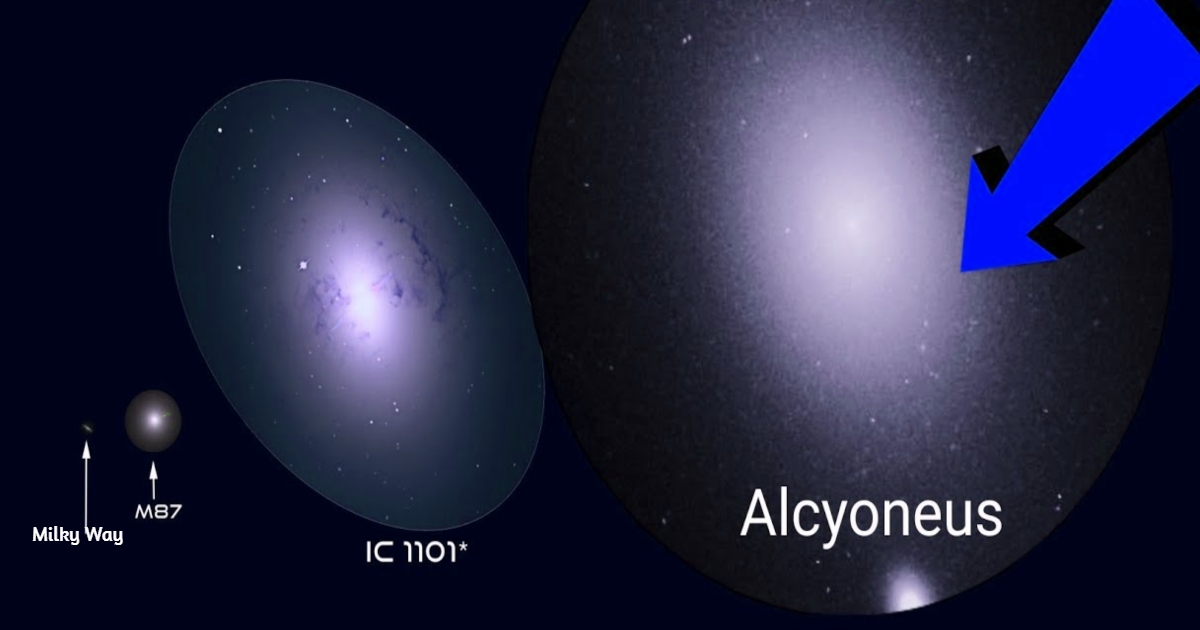Alcyoneus Galaxy – Largest Galaxy Ever, is a supergiant Radio galaxy stretching at least 16 million light-years in size. However, what truly sets Alcyoneus apart are its extensive radio lobes, gigantic plumes of radio waves emanating from the galaxy’s core.
These lobes stretch an incredible 5 million light-years on either side, bringing the galaxy’s total extent to a staggering 16 million light-years. To put this into perspective, if our Milky Way Galaxy were placed next to Alcyoneus, it would appear like a mere speck in comparison.

The Powerhouse Within:
The source of Alcyoneus’s immense radio lobes lies at its very heart, a supermassive black hole. These colossal black holes are known to reside at the center of most galaxies, and Alcyoneus is no exception. The supermassive black hole within Alcyoneus is likely millions, if not billions, of times more massive than our Sun.
This gravitational behemoth devours any matter that ventures too close, releasing tremendous amounts of energy in the process. Some of this energy is ejected in the form of powerful jets traveling near the speed of light. As these jets interact with the surrounding interstellar medium, they generate the vast radio lobes that characterize Alcyoneus.
Mysteries Unfold:
Despite the awe-inspiring details we’ve uncovered about Alcyoneus, much remains shrouded in mystery. Determining the exact mass of the galaxy is an ongoing challenge due to its immense distance from Earth, estimated to be around 2.7 billion light-years.
Additionally, the stellar population within Alcyoneus is yet to be fully characterized. Supergiant elliptical galaxies like Alcyoneus are typically dominated by older, redder stars. However, a more detailed analysis is needed to paint a clearer picture of the stars that call this colossal galaxy home.
What is the Structure (Anatomy) of the Alcyoneus Galaxy?
Unlike the spiral arms that grace our Milky Way, Alcyoneus boasts a distinct anatomy, offering a glimpse into the diversity of galactic forms.
The Central Stellar Body:
At the core of Alcyoneus lies a massive bulge of stars, aptly named the central stellar body. This densely packed region, estimated to be 150,000 light-years in diameter, harbors a predominantly older stellar population.
These stars, typically cooler and redder than their younger counterparts, paint a picture of a mature galactic core. Unlike the swirling arms of spiral galaxies, the stars in Alcyoneus’s central body are thought to be arranged in a more spherical or elliptical form.
The Energetic Engine (Supermassive Black Hole):
Lurking within the heart of the central stellar body is a powerhouse, a supermassive black hole. Millions, if not billions, of times more massive than our Sun, this gravitational behemoth exerts a tremendous influence on the surrounding galaxy.
The supermassive black hole is likely fueled by the relentless pull of its immense gravity, devouring any matter that ventures too close. This process unleashes tremendous amounts of energy, shaping the galaxy’s dynamics and contributing to the formation of the awe-inspiring radio lobes.
The Colossal Radio Lobes:
One of the most striking features of the Alcyoneus Galaxy is its extensive radio lobes. These giant plumes of radio waves, stretching an incredible 5 million light-years on either side of the central stellar body, contribute significantly to the galaxy’s record-breaking total extent of 16 million light-years.
The origin of these radio lobes lies in the supermassive black hole at the galaxy’s core. As the black hole devours matter, it also launches powerful jets of particles outward at near the speed of light. These jets interact with the surrounding gas and magnetic fields, generating the vast radio emission that defines the lobes.
The Enigmatic Halo:
Enveloping the central stellar body and radio lobes is a vast, diffuse region known as the halo. The halo of Alcyoneus is likely composed of dark matter, a mysterious substance that cannot be directly observed but exerts a gravitational pull, influencing the galaxy’s overall structure.
Additionally, the halo might harbor a sparse population of stars and gas, but much remains unknown about its composition and dynamics.

What is the Alcyoneus Galaxy’s Distance from Earth?
The Alcyoneus Galaxy is a giant radio galaxy located roughly 3.5 billion light-years away in the constellation Lynx.
What is the Size of the Alcyoneus Galaxy?
The Alcyoneus Galaxy is the largest known structure of galactic origin, spanning 16.3 million light-years.
What is the Mass of the Alcyoneus Galaxy?
The central host galaxy of Alcyoneus has an estimated stellar mass of 240 billion solar masses.
Why It was named Alcyoneus?
The galaxy, named Alcyoneus after the son of Ouranos, the Greek primal god of the sky, was discovered roughly 3 billion light-years from Earth by a “stroke of luck,” according to a statement from the Netherlands’ Leiden University.
When and Who Discovered Alcyoneus Galaxy?
The credit for unveiling Alcyoneus goes to a team of astronomers led by Dr. Martijn Oei from the University of Leiden in the Netherlands. Their exploration wasn’t fueled by a traditional telescope but by the innovative Low-Frequency Array (LOFAR). This network of radio telescopes, scattered across Europe, became the key to unlocking the secrets of Alcyoneus.
Researchers used data from the Low-Frequency Array (LOFAR) network of radio telescopes throughout Europe to find two huge plasma plumes generated by an apparently typical supermassive black hole at the galaxy’s center.
According to the statement, these two jet streams are at least 16 million light-years long and more than 100 Milky Ways wide, making them the biggest known galactic structure.
The material propelled into space by these two jet streams contains the building materials for fresh star formation. This substance heats up and melts into plasma as it travels at near-lightspeed, emitting radio light that LOFAR can detect.
Future Exploration of Alcyoneus Galaxy:
The discovery of Alcyoneus marks a significant milestone in our quest to understand the universe. Powerful telescopes like the Atacama Large Millimeter/submillimeter Array (ALMA) and the James Webb Space Telescope hold immense promise for further exploration.
By studying Alcyoneus at different wavelengths of light, astronomers hope to unveil the composition of its gas and dust, the dynamics of its stellar populations, and the behavior of the supermassive black hole at its core. These future observations will undoubtedly shed new light on this enigmatic celestial giant and its place in the grand tapestry of the cosmos.
Significance of Alcyoneus Galaxy:
Alcyoneus may provide fresh insights into the structure of our universe, also known as the cosmic web, which is thought to connect all galaxies. This complicated network is made up of filaments of clustered galaxies separated by massive gaps.
The intergalactic medium between galaxies may help shape the galaxy’s huge plasma plumes. According to the release, the researchers intend to do more studies into Alcyoneus’ habitat to determine whether anything in its surroundings can explain its remarkable development.
The discovery of Alcyoneus not only expands our understanding of the sheer scale of the universe but also offers valuable insights into galaxy evolution. The presence of such a massive black hole at its core suggests that Alcyoneus might have undergone a particularly violent and dynamic past.
Merging with smaller galaxies or interacting with other celestial giants could have fueled the growth of the central black hole and shaped the overall structure of Alcyoneus. Studying Alcyoneus can provide clues about the processes that shape the evolution of supergiant elliptical galaxies and the role of supermassive black holes in this cosmic drama.

Alcyoneus Galaxy – Largest Galaxy Ever as compared to IC 1101 Galaxy – Second Largest Galaxy:
Alcyoneus Galaxy Vs. IC 1101 Galaxy
| Feature | Alcyoneus Galaxy | IC 1101 Galaxy |
|---|---|---|
| Galaxy Type | Supergiant Radio Galaxy | Supergiant Elliptical Galaxy |
| Distance from Earth | Approximately 2.7 billion light-years | Approximately 1.04 billion light-years |
| Stellar Population | Likely dominated by older, red stars | Likely dominated by older, red stars |
| Structure | Spherical or elliptical shape with no distinct arms | Spherical or elliptical shape with no distinct arms |
| Size | 16 million light-years | 4 million light-years |
| Notable Features | Holds the record for largest total extent due to massive radio lobes | Holds the title of “second largest” in some older sources (diameter only) |
Conclusion:
The Alcyoneus Galaxy serves as a powerful reminder of the vastness and wonders that lie beyond our own corners of the universe. It compels us to constantly push the boundaries of our knowledge and explore the unknown with insatiable curiosity.
As we delve deeper into the mysteries of Alcyoneus and other celestial giants, we not only expand our understanding of the cosmos but also gain a deeper appreciation for the awe-inspiring scale and beauty of our universe.
